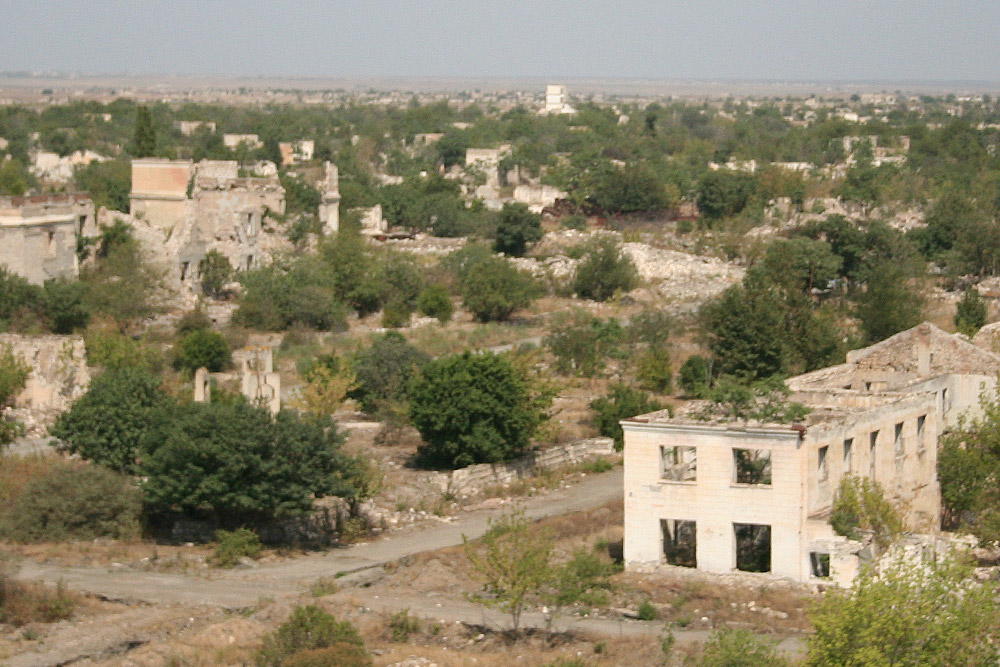Armenian actions in occupied lands damage arable land, pollute rivers: experts

By Sara Rajabova
A working group engaged in the evaluation of the damage inflicted to the Armenian-occupied territories of Azerbaijan has revealed important information on the issue, Azertag news agency reported.
According to the working group, led by Azerbaijani MP, professor Khanhuseyn Kazimli, recently hot and dry climatic conditions have persisted, which is not inherent to Azerbaijan, and this situation continues to cause major problems for the country.
Armenia is seizing the opportunity to further exacerbate this situation and reduce the productivity in the lowland parts of the country, sharply reducing the amount of rainfall in those regions by using Soviet-era cloud-fanning cannons, in the heights of Nagorno-Karabakh, an occupied Azerbaijani region.
In order to aggravate the complications that the draught can cause, the Armenians are completely halting the water supply to the lowland regions of Azerbaijan from the reservoirs built on Gargarchay and Tartarchay rivers during the summer months and committing large-scale arsons in the occupied territories, which leads to the crossing of various infestants and rodents from these areas to the lowland regions of the country.
Rodents, infestants and poisonous snakes, which pass to the lowland areas of the country escaping from the fires, intrude into the fields and private farms massively, destroying the cultivated fields and at the same time seriously threatening the lives of people.
Armenian armed forces set fire to the occupied Azerbaijani territories frequently. The arsons have caused massive loss of natural resources, flora and fauna. The fires also adversely affect the agriculture of the villages located in the frontline areas, as the Armenians deliberately set fire to the territories in the spring and summer months when crops are cultivated and harvested.
The persistent fires in the occupied territories and in the protected areas along Araz River are destroying the entire plant cover in these areas and have bitter ramifications for the environment.
As if that weren't enough, the Armenians pollute the fresh water reservoirs, especially those of Araz River, with poisonous waste substances of the copper mines and chemical plants of Armenia.
They also render useless the vacant fields, which they keep under their control by mining them.
In addition, in winter the Armenians flush the water collected during the year in the reservoirs built on Gargarchay and Tartarchay to the lowland regions of Azerbaijan; they throw explosives through the stream, which subsequently leads to serious casualties among the Azerbaijani people.
In 2007-2011 Armenia dumped over 2,329 tons of poisonous substances into the atmosphere in Nagorno-Karabakh and the adjacent regions. 2074.9 tons of it was dust, 40.22 tons sulphur dioxide, 37.24 tons nitric oxide and 176.44 tons carbon oxide.
Also, during these years, 215.25 tons of poisonous substances were dumped into the water, and 165.222 tons of it was slurry, 0.369 tons ammoniac and 0.76 tons synthetic substances.
Moreover, the working group has started the process of estimating the damage inflicted to the Nakhchivan Autonomous Republic by Armenia.
As a result of the Armenian aggression and separatism in the early 1990s, overland communications between the Nakhchivan Autonomous Republic and the rest of Azerbaijan were completely broken off.
Azerbaijani Deputy Prime Minister Ali Hasanov said earlier that the damage caused to Azerbaijan by the Armenian aggression is estimated at $300 billion. He noted that if Armenia fails to relinquish its non-constructive position, Azerbaijan will demand payment of these funds as compensation.
For over two decades, Azerbaijan and Armenia have been locked in conflict which emerged over Armenia's territorial claims against its South Caucasus neighbor. Since a war in the early 1990s, Armenian armed forces have occupied 20 percent of Azerbaijan's territory, including Nagorno-Karabakh and seven surrounding regions. A fragile ceasefire has been in place since 1994, but long-standing efforts by US, Russian and French mediators have been largely fruitless so far. Armenia has not yet implemented the U.N. Security Council's four resolutions on its pullout from the neighboring country's territories.
Here we are to serve you with news right now. It does not cost much, but worth your attention.
Choose to support open, independent, quality journalism and subscribe on a monthly basis.
By subscribing to our online newspaper, you can have full digital access to all news, analysis, and much more.
You can also follow AzerNEWS on Twitter @AzerNewsAz or Facebook @AzerNewsNewspaper
Thank you!
